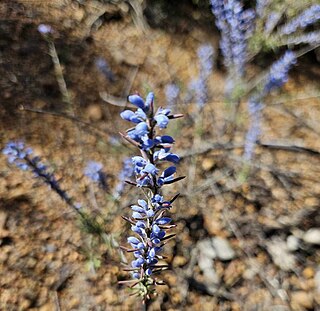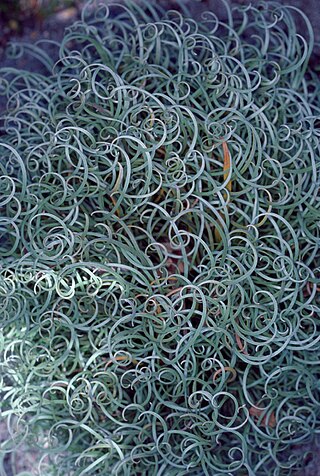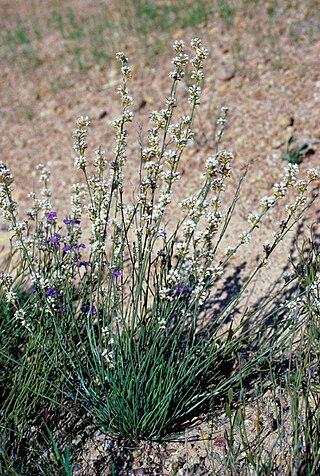
Conospermum glumaceum, commonly known as hooded smokebush, is a species of flowering plant in the family Proteaceae and is endemic to the south-west of Western Australia. It is an erect shrub with more or less clustered, linear leaves, and panicles of dense, head-like spikes of tube-shaped, cream-coloured flowers and white to golden nuts.

Conospermum amoenum, commonly known as blue smokebush, is a species of flowering plant in the family Proteaceae and is endemic to the south-west of Western Australia. It is an erect or spreading shrub with linear leaves, and spikes of blue or white tube-shaped flowers.

Conospermum canaliculatum is a species of flowering plant in the family Proteaceae, and is endemic to the south-west of Western Australia. It is a dense, multistemmed, erect shrub with linear leaves and spike-like panicles of woolly white, tube-shaped flowers.

Conospermum capitatum is a species of flowering plant in the family Proteaceae, and is endemic to the south-west of Western Australia. It is a low, erect shrub with coiled leaves and head-like panicles of red to pale yellow and hairy, tube-shaped flowers.

Conospermum cinereum is a species of flowering plant in the family Proteaceae and is endemic to the south west of Western Australia. It is a spindly shrub with egg-shaped to lance-shaped leaves, loose spikes of woolly, tube-shaped white flowers and woolly nuts.

Conospermum coerulescens is a species of flowering plant in the family Proteaceae and is endemic to the south of Western Australia. It is an erect shrub with thread-like to narrowly lance-shaped leaves and spikes of up to 10 greyish-blue to deep blue, hairy flowers.

Conospermum densiflorum, commonly known as crown smokebush, is a species of flowering plant in the family Proteaceae and is endemic to the south-west of Western Australia. It is an erect, much-branched shrub with thread-like leaves at the base of the plant, and spikes or corymbs of velvety, cream-coloured or blue, tube-shaped flowers.

Conospermum eatoniae, commonly known as blue lace, is a species of flowering plant in the family Proteaceae and is endemic to the south-west of Western Australia. It is a spreading shrub with egg-shaped leaves only present on young plants, and panicles of glabrous blue, tube-shaped flowers with pale green bracteoles.

Conospermum ephedroides is a species of flowering plant in the family Proteaceae and is endemic to the south-west of Western Australia. It is a tufted shrub with many stems, a few cylindrical leaves at the base of the plant, and sessile spikes of glabrous white, pale pink or blue, tube-shaped flowers and reddish-brown to orange nuts.

Conospermum filifolium is a species of flowering plant in the family Proteaceae and is endemic to the south-west of Western Australia. It is a shrub with thread-like, S-shaped leaves, and spike-like panicles of woolly white, occasionally blue, tube-shaped flowers.

Conospermum floribundum is a species of flowering plant in the family Proteaceae and is endemic to the south of Western Australia. It is a compact, erect shrub with narrowly linear leaves that are circular in cross-section, and spike-like panicles of white, tube-shaped flowers with blue tips.
Conospermum galeatum is a species of flowering plant in the family Proteaceae and is endemic to the south-west of Western Australia. It is an open shrub with threadlike, channelled leaves, and panicles of spikes of woolly white flowers with blue bracteoles.

Conospermum huegelii, commonly known as the slender smokebush, is a species of flowering plant endemic to the south-west of Western Australia. It is a low, clumped shrub with thread-like to narrowly cylindrical leaves, and spikes of pale blue to cream-coloured, tube-shaped flowers and hairy nuts.

Conospermum leianthum is a species of flowering plant in the family Proteaceae and is endemic to the south-west of Western Australia. It is a shrub with thread-like leaves, and panicles of white and more or less purple, tube-shaped flowers.
Conospermum microflorum is a species of flowering plant of the family Proteaceae and is endemic to Western Australia. It is a rounded shrub with glabrous, thread-like leaves, panicles of woolly hairy, white or cream coloured flowers and woolly hairy, orange-brown nuts.
Conospermum multispicatum is a species of flowering plant of the family Proteaceae and is endemic to the south-west of Western Australia. It is a dense, rounded shrub with glabrous leaves that are round in cross section, spikes of woolly hairy, white flowers and woolly hairy nuts.

Conospermum nervosum is a species of flowering plant in the family Proteaceae and is endemic to the south-west of Western Australia. It is an erect, much-branched shrub with oblong to egg-shaped leaves, and spikes of blue to pink, tube-shaped flowers.
Conospermum paniculatum is a species of flowering plant in the family Proteaceae and is endemic to the south-west of Western Australia. It is an erect, much-branched shrub with spoon shaped to egg-shaped leaves with the narrower end towards the base, and spikes of blue to pink, tube-shaped flowers, the fruit an urn-shaped nut.

Conospermum scaposum is a species of flowering plant in the family Proteaceae and is endemic to the south-west of Western Australia. It is a low, erect shrub with linear leaves and dense spikes of blue, tube-shaped flowers covered with long, silky hairs.

Conospermum spectabile is a species of flowering plant in the family Proteaceae and is endemic to the south-west of Western Australia. It is an erect, compact shrub with S-shaped leaves that are circular in cross section, and panicles of woolly white and blue, tube-shaped flowers.
















